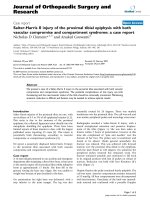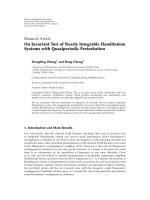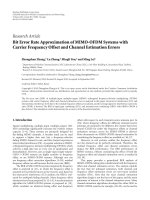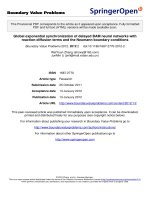Stabilization of semi markovian jump systems with uncertain probability intensities and its extension to quantized control
Bạn đang xem bản rút gọn của tài liệu. Xem và tải ngay bản đầy đủ của tài liệu tại đây (201.76 KB, 30 trang )
REPUBLIC OF KOREA
UNIVERSITY OF ULSAN
(School of Electrical Engineering)
Stabilization of semi-Markovian
jump systems with uncertain
probability intensities and its
extension to quantized control
SUMMARY OF
DISSERTATION
for the Degree of
MASTER OF ENGINEERING
(Electrical Engineering)
NGUYEN NGOC HOAI AN
November 2016
The dissertation is officially defended at
UNIVERSITY OF ULSAN, Ulsan City, South Korea
Advisor
Professor, Ph.D. Sung Hyun, Kim
School of Electrical Engineering, University of Ulsan
Professor Committee 1
Ph.D. Sung Hwan, Kim
School of Electrical Engineering, University of Ulsan
Professor Committee 2
Ph.D. Jong Pil Yun
Korean Institute of Industrial Technology
The Dissertation was officially defended in the Master Dissertation Defense Presentation held by the School of Electrical Engineering, University of Ulsan on November 28, 2016. There, the
Dissertation named ”Stabilization of semi-Markovian jump systems with uncertain probability intensities and its extension to
quantized control” was successfully defended by graduate student Nguyen Ngoc Hoai An.
VITA
Nguyen Ngoc Hoai An was born in Da Nang City, Viet Nam on June
22, 1990. She received the B.E. degree (2013) in Electrical Engineering from
Da Nang University of Technology, Da Nang City, Viet Nam.
In March 2015, she began working full time towards her M.E. at University of Ulsan, South Korea under the supervisor of Professor Kim Sung Hyun.
Since then, she has conducted researches in Embedded Control Eystem Laboratory.
ACKNOWLEDGEMENTS
I would like to express my sincere gratitude to my dissertation advisor,
Professor Kim Sung Hyun, for giving me a lot of opportunities to be part of
his research and for his supervisor which helped me complete this work. I
am greatly indebted to him for his full support, constant encouragement and
advice both in technical and non-technical matters.
I would also like to thank the other members of my M.E. supervisory
committee for many useful interactions and for contributing their broad perspective in redefining the ideas in this dissertation.
I am grateful to my friends, my lab mate of Embedded Control System
Laboratory (ECSL), University of Ulsan (UOU), for their friendship, enthusiastic help and cheerfulness during my stay in South Korea.
The financial support of the BK21 and BK21+ programs is also gratefully
acknowledged.
Last, but certainly not the least, I would like to thank my family for their
spirit support and encouragement during the course of my studies.
Especially, my parents and my younger brother have always believed in
me and have supported every endeavor of mine.
ABSTRACT
Stabilization of semi-Markovian jump
systems with uncertain probability intensities
and its extension to quantized control
by
Nguyen Ngoc Hoai An
Advisor: Prof. Kim Sung Hyun
This dissertation concentrates on the issue of stability analysis and control
synthesis for semi-Markovian jump systems (S-MJSs) with uncertain probability intensities.
Here, to construct a more applicable transition model for S-MJSs, the
probability intensities are taken to be uncertain, and this property is totally
reflected in the stabilization condition via a relaxation process established
on the basis of time-varying transition rates. Moreover, an extension of the
proposed approach is made to tackle the quantized control problem of SMJSs, where the infinitesimal operator of a stochastic Lyapunov function is
clearly discussed with consideration of input quantization errors. Simulation
examples show the effectiveness of the proposed method.
3
Notation
Some following notations are used in this dissertation.
The notation X ≥ Y and X − Y means that X − Y is positive semi-definite
and positive definite, respectively. In symmetric block matrices, (∗) is used
as an ellipsis for terms induced by symmetry. For any square matrix Q,
He[Q] = Q + QT where QT denotes the transpose matrix of the squared
△
matrix Q. For N+
s = {1, 2, . . . , s},
Q11 . . . Q1s
[ ]
[ ]
△
△
.. ,
...
Qi i∈N+s = [Q1 Q2 . . . Qs ], Qij i,j∈N+s = ...
.
Qs1 . . . Qss
0
Q
Q
.
.
.
Q
12
13
1s
Q1 0 . . . 0
0
0
Q23 . . . Q2s
[ ]D △ 0 Q2 . . . ...
△ . .
[ ]U
.
.
.
.
.
.
.
.
Qi i∈N+s = . .
, Qij i,j∈N+s = .
,
. .
. .
.
.. .. 0
..
0 ...
. . . 0 Q(s−1)s
0 . . . 0 Qs
0 ...
... 0
0
where Qi and Qij denote real submatrices with appropriate dimensions or
scalar values. The notation E[•] denotes the mathematical expectation, and
diag(•) stands for a block-diagonal matrix. The notation λmax (•) denotes the
maximum eigenvalue of the argument, and exp(•) indicates the exponential
distribution.
Table of contents
Vita . . . . . . . .
Acknowledgements
Abstract . . . . . .
Notation . . . . . .
.
.
.
.
.
.
.
.
.
.
.
.
.
.
.
.
.
.
.
.
.
.
.
.
.
.
.
.
.
.
.
.
.
.
.
.
.
.
.
.
.
.
.
.
.
.
.
.
.
.
.
.
.
.
.
.
.
.
.
.
.
.
.
.
.
.
.
.
.
.
.
.
.
.
.
.
.
.
.
.
.
.
.
.
.
.
.
.
.
.
.
.
.
.
.
.
1
2
3
4
1 INTRODUCTION
1.1 Motivation . . . . . . . . . . . . . . . . . . . . . . . . . . . . .
1.2 Previous works . . . . . . . . . . . . . . . . . . . . . . . . . .
1.3 Research Contribution . . . . . . . . . . . . . . . . . . . . . .
7
7
8
8
2 STOCHASTIC STABILITY ANALYSIS
2.1 Introduction . . . . . . . . . . . . . . . .
2.2 System description . . . . . . . . . . . .
2.3 Stochastic Stability Analysis . . . . . . .
2.4 Conclusion . . . . . . . . . . . . . . . . .
.
.
.
.
3 RELAXED STOCHASTIC STABILITY
3.1 Introduction . . . . . . . . . . . . . . . .
3.2 Probability intensity analysis . . . . . . .
3.3 Relaxed Stochastic Stability Analysis . .
3.4 Conclusion . . . . . . . . . . . . . . . . .
ANALYSIS
. . . . . . . .
. . . . . . . .
. . . . . . . .
. . . . . . . .
4 CONTROL DESIGN
4.1 Introduction . . . . . . . . . . .
4.2 Control design . . . . . . . . . .
4.3 Extension on input quantization
4.4 Conclusion . . . . . . . . . . . .
5
. . .
. . .
error
. . .
.
.
.
.
.
.
.
.
. . . . .
. . . . .
control
. . . . .
.
.
.
.
.
.
.
.
.
.
.
.
.
.
.
.
.
.
.
.
.
.
.
.
.
.
.
.
.
.
.
.
.
.
.
.
.
.
.
.
.
.
.
.
.
.
.
.
.
.
.
.
.
.
.
.
.
.
.
.
.
.
.
.
.
.
.
.
.
.
.
.
.
.
.
.
.
.
.
.
.
.
.
.
.
.
.
.
.
.
.
.
10
10
10
11
12
.
.
.
.
13
13
13
14
15
.
.
.
.
16
16
16
17
18
Table of Contents
5 SIMULATION RESULTS
19
5.1 Example 1 . . . . . . . . . . . . . . . . . . . . . . . . . . . . . 19
5.2 Example 2 . . . . . . . . . . . . . . . . . . . . . . . . . . . . . 19
6 SUMMARY OF CONTRIBUTIONS AND FURTHER WORKS 22
6.1 Introduction . . . . . . . . . . . . . . . . . . . . . . . . . . . . 22
6.2 Summary of Contributions . . . . . . . . . . . . . . . . . . . . 22
6.3 Future Research Directions . . . . . . . . . . . . . . . . . . . . 23
Publication
23
Reference
24
Page 6
Chapter 1
INTRODUCTION
1.1
Motivation
Over the past few decades, considerable attention has been paid to Markovian jump systems (MJSs) since such systems are suitable for representing a
class of dynamic systems subject to random abrupt variations. In addition to
the growing interest from their representation ability, MJSs have been widely
applied in many practical applications, such as manufacturing systems, aircraft control, target tracking, robotics, networked control systems, solar receiver control, and power systems (see [1, 2, 3, 4, 5, 6, 7, 8, 9, 10, 11, 12]
and references therein). Following this trend, numerous investigations are
underway to deal with the issue of stability analysis and control synthesis
for MJSs with complete/incomplete knowledge of transition probabilities in
the framework of filter and control design problems: [13, 14, 15, 16] with a
complete description of transition rates, and [17, 18, 19, 20, 21, 22] without
a complete description. Generally, in MJSs, the sojourn-time is given as
a random variable characterized by the continuous exponential probability
distribution, which tends to make the transition rates time-invariant due to
the memoryless property of the probability distribution. The thing to be
noticed here is that the use of constant transition rates plays a limited role
in representing a wide range of application systems (see [23, 24, 25]). Thus,
another interesting topic has recently been studied in semi-Markovian jump
systems (S-MJSs) to overcome the limitation of this memoryless property.
7
Chapter 1: INTRODUCTION
1.2
Previous works
As reported in [26, 27, 28], the mode transition of S-MJSs is driven by a
continuous stochastic process governed by the nonexponential sojourn-time
distribution, which leads to the appearance of time-varying transition rates.
Thus, it has been well recognized that S-MJSs are more general than MJSs
in real situations. Further, with this growing recognition, various problems
on S-MJSs have been widely studied for successful utilization of a variety of
practical applications (see [23, 24, 27, 31, 32, 33, 34] and references therein).
Of them, the first attempt to overcome the limits of MJSs was made by
[23, 24] for the stability analysis of systems with phase-type (PH) semiMarkovian jump parameters, which was extended to the state estimation
and sliding mode control by [33]. Besides, [27] considered the Weibuill distribution for the stability analysis of S-MJSs and introduced a sojourn-time
partition technique to make the derived stability criterion less conservative.
Continuing this, [32] applied the sojourn-time partition technique to the design of H∞ state-feedback control for S-MJSs with time-varying delays. After that, another partition technique of dividing the range of transition rates
was proposed by [31] to derive the stability and stabilization conditions of
S-MJSs with norm-bounded uncertainties. Most recently, [35] designed a reliable mixed passive and H∞ filter for semi-Markov jump delayed systems
with randomly occurring uncertainties and sensor failures. Also, [28] considered semi-Markovian switching and random measurement while designing a
sliding mode control for networked control systems (NCSs). Based on the
above observations, it can be found that their key issue mainly lies in finding
more applicable transition models for S-MJSs, capable of a broad range of
cases. In this light, one needs to explore the impacts of uncertain probability
intensities in the study of S-MJSs, and then provide a relaxed stability criterion absorbing the property of the resultant time-varying transition rates.
However, until now, there have been almost no studies that intensively establish a kind of relaxation process corresponding to the stabilization problem
of S-MJSs with uncertain probability intensities.
1.3
Research Contribution
This dissertation addresses the issue of stability analysis and control synthesis for S-MJSs with uncertain probability intensities. One of the main
Page 8
Chapter 1: INTRODUCTION
contributions is to discover more reliable and scalable transition models for
S-MJSs on the basis of their time-varying and boundary properties. To this
end, this dissertation provides a valuable theoretical approach of constructing
a practical transition models for S-MJSs 1) by taking into account uncertain
probability intensities, and 2) by reflecting their available bounds in the transition rate description. Further, in a different manner from other works, all
constraints on time-varying transition rates are totally incorporated into the
stabilization condition via a relaxation process established on the basis of
time-varying transition rates. Here, it is worth noticing that the relaxation
process is developed in such a way that all possible slack variables can be
included therein. In contrast to other works, the relaxation process plays a
key role in obtaining a finite and solvable set of linear matrix inequalities
(LMIs) from parameterized matrix inequalities (PLMIs) arising from uncertain probability intensities. On the other hand, the quantization module
that converts real-valued measurement signals into piecewise constant ones
has been commonly used to implement a variety of networked control systems over wired or wireless communications (see [29, 30]). Especially, among
optical wireless communications, the visible light communication can be applied as a data communication channel to transmit the control input to the
S-MJSs under consideration. Thus, as an extension, this dissertation tackles
the quantized control problem of S-MJSs, where the infinitesimal operator of
a stochastic Lyapunov function is clearly discussed with consideration on input quantization errors. In addition, this dissertation proposes a method for
reducing the influence of input quantization errors in the control of S-MJSs,
which is also one of main contributions. Finally, simulation examples show
the effectiveness of the proposed method.
Page 9
Chapter 2
STOCHASTIC STABILITY
ANALYSIS
2.1
Introduction
This chapter indicates the original stochastically stability condition for SMJSs system without control input consideration. The original stability
condition is established based on Lyapunov stability method. Moreover, the
system description are also written in details for total explanation on this
dissertation.
2.2
System description
Let us consider the following continuous-time semi-Markovian jump linear
systems (S-MJSs):
x(t)
˙
= A(ζ(t))x(t) + B(ζ(t))u(t),
(2.1)
where x(t) ∈ Rnx and u(t) ∈ Rnu denote the state and the control input,
respectively. Here, {ζ(t), t ≥ 0} denotes a continuous-time semi-Markov
process that takes values in the finite space N+
s and further has the mode
transition probabilities:
{
(
)
πij (h)h + o(h),
if j ̸= i
,
(2.2)
Pr ζ(t + h) = j|ζ(t) = i =
1 + πii (h)h + o(h), if j = i
10
Chapter 2: STOCHASTIC STABILITY ANALYSIS
where limh→0 (o(h)/h) = 0 and πij (h) denotes
the transition rate from mode
∑
i to mode j at time t + h and πii (h) = − sj=1,j̸=i πij (h). Further, h indicates
the sojourn-time elapsed when the system stays at mode i from the last jump
(i.e., h is set to 0 when the system jumps). In particular, the transition rate
]
△ [
matrix Π(h) = πij (h) i,j∈N+s belongs to the following set:
{
∑
[ ]
△
(1)
SΠ = πij i,j∈N+s 0 =
πij and 0 ≤ µij πij ,
j∈N+
s
where µij
}
j̸=i
= 1, µij
j=i
= −1, ∀i, j ∈ N+
.
s
Before going ahead, for later convenience, we define the system matrix for the
△
△ [
ith mode as (Ai , Bi ) = (A(ζk = i), B(ζk = i)), and set Πi (h) = πi1 (h) · · ·
]T [
]T
πis (h) = πij (h) j∈N+s . Also, to deal with the stability analysis problem in
such a stochastic setting, we consider the following definition.
Definition 1 An S-MJS (2.1) with u(t) = 0 is stochastically stable if its
solution is such that for any initial condition x0 and ζ0 ,
]
[∫ t
2
∥x(τ )∥ dτ x0 , ζ0 < ∞.
(2.3)
lim E
t→∞
2.3
0
Stochastic Stability Analysis
First of all, let us consider (2.1) with u(t) ≡ 0:
x(t)
˙
= A(ζ(t))x(t).
(2.4)
The following lemma presents the stochastic stability condition for (2.4) with
(1)
Π(h) ∈ SΠ .
Lemma 1 Suppose that there exists Pi > 0, for all i ∈ N+
s , such that
(1)
0 > Qi (h), Π(h) ∈ SΠ , ∀i ∈ N+
s,
△
where Qi (h) = He(Pi Ai ) +
(1)
SΠ
∑s
j=1
(2.5)
πij (h)Pj . Then, S-MJSs (2.4) with Π(h) ∈
are stochastically stable.
PROOF The proof of Lemma 1 is shown in my full Dissertation.
Page 11
Chapter 2: STOCHASTIC STABILITY ANALYSIS
2.4
Conclusion
In this Chapter, the Lemma 1 and its Proof is given to reveal the original
stochastically stability condition for the S-MJSs with u(t) = 0. In the next
Chapter, the probability intensity analysis will be represented and proven
and lead to another important constraints on stability condition Those new
constraints are accompanied by the original condition construct the Lemma 2
which is the final stability condition for the S-MJSs in that case. After that,
relaxation technique will be shown its role in converting the final stability
condition.
Page 12
Chapter 3
RELAXED STOCHASTIC
STABILITY ANALYSIS
3.1
Introduction
In this chapter, the probability intensity is analyzed and added into the
original stochastically stability condition which is proven in previous chapter.
The total properties from stochastic stability conditions cause three main
sufficient constraints in the final stability condition for S-MJSs with u(t) =
0. Technically, those stability conditions are revised to the finite LMI-form
thanks to the relaxation technique, which is the most important technique
in this dissertation.
3.2
Probability intensity analysis
In our research, as a model of probability distribution for the sojourn-time
h ≥ 0, we utilize the Weibull distribution with shape parameter β > 0
and scale parameter α > 0, since such a distribution has been witnessed as
an appropriate choice for representing the stochastic behavior of practical
systems. In other words, to represent the probability distribution of h, its
cumulative function Gi (h) and probability distribution function gi (h) are
13
Chapter 3: RELAXED STOCHASTIC STABILITY ANALYSIS
given as follows: for all i and j (j ̸= i) ∈ N+
s,
( ( ) )
( ( ) )
β
β
h i
h i
βi βi −1
and gi (h) = βi h
exp −
,
Gi (h) = 1 − exp −
αi
αi
αi
(3.1)
which leads to
πij (h) = qij πi (h) = qij
gi (h)
βi
= qij βi hβi −1 .
1 − Gi (h)
αi
(3.2)
As a special case, let βi = 1. Then, we can represent MJSs from (3.2), that
is, the transition rate πij (h) can be reduced to an h-independent value as
follows: πij (h) = qij πi (h) = qij /αi . Accordingly, it can be claimed that (3.2)
expresses a more generalized transition model, compared to the case of MJSs.
Remark 1 As shown in (3.2), the transition rate πij (h) is time-varying and
depends on the probability intensity qij . Thus, to derive a finite number of
solvable conditions from (2.5), there is a need to consider the lower and upper
bounds of both πi (h) and qij , respectively, as follows: πi,1 ≤ πi (h) ≤ πi,2 and
qij,1 ≤ qij ≤ qij,2 . Then, from πij (h) = qij πi (h), the bounds of πij (h) are
decided as follows: πij,1 ≤ πij (h) ≤ πij,2 , where
{
{
qij,1 · πi,1 ,
if j ̸= i
qij,2 · πi,2 ,
if j ̸= i
πij,1 =
and πij,2 =
.
− πi,2 ,
otherwise
− πi,1 ,
otherwise
In accordance with Remark 1, an auxiliary constraint can be established as
(2)
follows: Π(h) ∈ SΠ , where
{
}
(2) △
SΠ = [πij ]i,j∈Ns+ πij,1 ≤ πij ≤ πij,2 , ∀i, j ∈ N+
s .
The following section presents the stochastic stability
condition for S-MJSs
(1) ∩ (2)
(2.4) with transition rates boundaries Π(h) ∈ SΠ
SΠ .
3.3
Relaxed Stochastic Stability Analysis
Lemma 2 Suppose that there exists Pi > 0, for all i ∈ N+
s , such that
∩ (2)
(1)
0 > Qi (h), Π(h) ∈ SΠ
SΠ , ∀i ∈ N+
(3.3)
s,
Page 14
Chapter 3: RELAXED STOCHASTIC STABILITY ANALYSIS
∑
△
where Qi (h) = He(Pi Ai ) + sj=1 πij (h)Pj and πij (h) ∈ [πij,1 , πij,2 ]. Then,
(1) ∩ (2)
S-MJSs (2.4) with SΠ
SΠ are stochastically stable.
However, it is worth noticing that solving (3.3) of Lemma 2 is still equivalent
to solving an infinite number of LMIs, which is an extremely difficult problem.
Thus, it is necessary to find a finite number of solvable LMI-based conditions
from (3.3). To this end, the following theorem provides a sufficient relaxed
(1) ∩ (2)
stochastic stability condition for (2.4) with Π(h) ∈ SΠ
SΠ .
{
}
Theorem 1 Suppose that there exists matrices Gi , Sij , Xij , Yij i,j∈N+s ∈ Rnx ×nx
{
}
and symmetric matrices Pi > 0 i∈N+s ∈ Rnx ×nx such that
]
[
(1, 1) (1, 2)
, ∀i ∈ N+
(3.4)
0>
s,
(∗) (2, 2)
0 ≤ He(Xij ), ∀i, j ∈ N+
s,
+
0 ≤ He(Yij ), ∀i, j ∈ Ns ,
(3.5)
(3.6)
where µij |j̸=i = 1, µij |j=i = −1,
(
) ∑
(
)
(1, 1) = He Pi Ai −
He πij,1 πij,2 Xij ,
[
j∈N+
s
]
1
,
(1, 2) = Pj + Gi + (πij,1 + πij,2 )Xij + µij Yij
2
j∈N+
s
[ (
)
([
)]D
]U
(2, 2) = He Sia − Xia
+
He
S
+
S
+ .
ia
ib
a,b∈Ns
+
a∈Ns
(1)
Then, S-MJSs (2.4) with Π(h) ∈ SΠ
∩
(2)
SΠ are stochastically stable.
PROOF The proof of Theorem 1 is shown in my full Dissertation
3.4
Conclusion
To sum up, this Chapter is successful in using relaxation technique to transform the infinite stability condition into the finite and solvable LMI form.
The Theorem 1 proven in this Chapter 3 is so important that the following generalized case of S-MJSs analysis will be inherited and developed. In
the next Chapter, the control design is conducted to generalize the stability
condition for S-MJSs via relaxation technique.
Page 15
Chapter 4
CONTROL DESIGN
4.1
Introduction
This chapter covers the control synthesis on stochastically stability condition
for the S-MJSs. The control input is considered in the S-MJSs system and
the final stability condition as proven in Chapter 3 is then adapted to the
current system model. Again, in this chapter, the relaxation technique places
a key role to successfully convert final stability conditions into the finite LMI
form. Further, as an extension, the condition of input quantization error
is reflected such that the input-quantized S-MJSs is stochastically stable
following to Theorem in Chapter 3.
4.2
Control design
Let us consider the following mode-dependent state-feedback control law:
u(t) = Fi x(t),
(4.1)
(
)
△
where Fi = F ζ(t) = i . Thereby, the resultant closed-loop system under
(2.1) and (4.1) is given by:
x(t)
˙
= Ai x(t) + Bi u(t) = (Ai + Bi Fi )x(t) = A¯i x(t).
(4.2)
The following theorem provides a ∩
relaxed stochastic stabilization condition
(1)
(2)
for S-MJSs (4.2) with Π(h) ∈ SΠ
SΠ .
16
Chapter 4: CONTROL DESIGN
{ }
{
Theorem 2 Suppose that there exist matrices F¯i i∈N+s ∈ Rnx ×nx and Gi ,
{
}
}
Sij , Xij , Yij , Qij i,j∈N+s ∈ Rnx ×nx , and symmetric matrices P¯i > 0 i∈N+s ∈
Rnx ×nx such that
]
[
(1, 1) (1, 2)
0>
, ∀i ∈ N+
(4.3)
s,
(∗) (2, 2)
0 ≤ He(Xij ), ∀i, j ∈ N+
s,
+
0 ≤ He(Yij ), ∀i, j ∈ Ns ,
[
]
Qij P¯i
0≤
, ∀i, j ̸= i ∈ N+
s,
(∗) P¯j
(4.4)
(4.5)
(4.6)
where ϵij |j̸=i = 1, ϵij |j=i = 0, µij |j̸=i = 1, µij |j=i = −1,
(
) ∑
(
)
(1, 1) = He Ai P¯i + Bi F¯i −
He πij,1 πij,2 Xij ,
[(
j∈N+
s
]
)
1
1
(1, 2) =
ϵij Qij + (1 − ϵij )P¯i + Gi + (πij,1 + πij,2 )Xij + µij Yij
,
2
2
j∈N+
s
[ (
([
)
)]D
]U
(2, 2) = He Sia − Xia
+ He Sia + Sib a,b∈N+s .
+
a∈Ns
(1)
Then, the closed-loop system (4.2) with Π(h) ∈ SΠ
stable, where Fi = F¯i P¯i−1 .
∩
(2)
SΠ is stochastically
PROOF The proof of Theorem 2 is shown in my full Dissertation
4.3
Extension on input quantization error control
Hereafter, as a practical extension of the proposed approach, we consider the
following input-quantized S-MJSs:
(
)
x(t)
˙
= Ai x(t) + Bi q u(t) ,
(4.7)
where q(•) stands for
quantization
operator
with the quantization
( a uniform
)
(
)
(
)
level δ > 0, i.e., q u(t) = δ · round u(t)/δ . Here, note that q u(t) =
u(t) + φ(t), where the kth element of the quantization error φ(t) satisfies
δ
φk (t) ≤ , ∀k ∈ N+
nu .
2
Page 17
Chapter 4: CONTROL DESIGN
Thus, (4.7) can be rewritten as
(
)
x(t)
˙
= Ai x(t) + Bi u(t) + φ(t) ,
(
)
where φ(t) = q u(t) − u(t) is known. Continuously, as a mode-dependent
state-feedback law, we adopt
u(t) = Fi x(t) + νi (t).
(4.8)
where νi (t) ∈ Rnu is the input quantization error. Then, the resultant closedloop system is described as
(
)
x(t)
˙
= A¯i x(t) + Bi νi (t) + φ(t) .
(4.9)
The following theorem provides a relaxed stochastic stabilization condition
for S-MJSs (4.9) with input quantization error.
Theorem 3 Let νi,k (i.e., the kth element of νi ) be given as follows:
(
(
)
(
))
+
νi,k (t) = −δ · sgn si,k (t) · max 0, sgn sTi (t)φ(t) , ∀i ∈ N+
s , k ∈ Nnu ,
(4.10)
the kth element
of si (t).
where si (t) = BiT Pi x(t) ∈ Rnu and{ si,k
{
} (t) denotes
nx ×nx
¯
and Gi , Sij , Xij , Yij ,
Suppose that there exist matrices Fi i∈N+s ∈ R
}
}
{
nx ×nx
¯
Qij i,j∈N+s ∈ R
, and symmetric matrices Pi > 0 i∈N+s ∈ Rnx ×nx such
(1) ∩ (2)
that (4.3)–(4.6) hold. Then, the closed-loop system (4.9) with Π(h) ∈ SΠ
SΠ
−1
¯
¯
is stochastically stable, where Fi = Fi Pi .
PROOF The proof of Theorem 3 is shown in my full Dissertation.
4.4
Conclusion
In conclusion, the stability control synthesis of S-MJSs is successfully proven
and defined. Therefore, the stability condition in Theorem 2 built on relaxation technique is efficient and applicable for the generalized S-MJSs. As an
extension on the stabilization analysis, the consideration on quantization error show the sufficient condition of input quantization error such that S-MJSs
is stable in Theorem 3.
Page 18
Chapter 5
SIMULATION RESULTS
5.1
Example 1
5.2
Example 2
Figure 3. shows the behavior of the state response for the mode transition generated according to (α1 , β1 ) = (0.5, 2.0), (α2 , β2 ) = (1.0, 2.0), and
(α3 , β3 ) = (1.5, 2.0). Here, the control input νi (t) is designed in accordance
with (4.10), and the quantization level is assumed to be δ = 0.1. From Fig.
6.3, it can be seen that the states converge from the initial-state condition
(1, −1, 0.5) to the origin as time increases. Consequently, Theorem 3 provides
a suitable mode-dependent control for the S-MJSs with input quantization
errors as well as uncertain probability intensities.
19
Chapter 5: SIMULATION RESULTS
(a)
(c)
(b)
1.8
1
G1(h)
1.6
1
0.9
g1(h)
g3(h)
1
0.8
0.6
0.7
(α3,β3) = (1.5,2.0)
(α2,β2) = (1.0,2.0)
(α1,β1) = (0.5,2.0)
0.8
1.2
0.6
0.4
0.6
0.5
0.4
0.3
G (h)
2
0.4
0.2
g2(h)
0.2
0.2
0
0
G3(h)
0.8
1.4
0.1
1
2
h
3
0
0
4
1
2
h
3
0
0
4
1
2
h
3
4
Figure 5.1: (solid line) Cumulative distribution functions Gi (h) and (dashdotted line) probability distribution functions gi (h).
mode ζ(t)
(a)
3
2
1
0
5
10
15
20
25
30
time (sec)
(b)
(c)
4
100
x1(t)
x2(t)
−2
−4
−6
0
5
80
numbers
0
control u(t)
state x(t)
2
10
60
40
0
time (sec)
−10
0
10
5
10
15
15
20
time (sec)
20
25
25
20
30
30
0
0
Figure 5.2: (a) mode evolution, (b) state response and control input, and (c)
Monte Carlo simulation results.
Page 20
5
10
15
20
settling time (sec)
25
Chapter 5: SIMULATION RESULTS
2
0
x1(t)
x2(t)
−2
3
mode ζ(t)
state x(t)
x3(t)
−4
−6
−8
2
1
0
2
4
−12
0
6
8
10
time (sec)
−10
1
2
3
4
5
time (sec)
6
7
Figure 5.3: State response and mode evolution.
Page 21
8
9
10
Chapter 6
SUMMARY OF
CONTRIBUTIONS AND
FURTHER WORKS
6.1
Introduction
This chapter is to summarize the main contributions of this dissertation and
to discuss further works. In particular, a brief summary of these results is
presented in the next section whereas concerning future research directions
are discussed in Section 6.3
6.2
Summary of Contributions
• The issue of stability analysis for S-MJSs with uncertain probability
intensities has been addressed in this dissertation.
• Here, the boundary constraints of probability intensities have been totally reflected in the stabilization condition via a relaxation process
established on the basis of time-varying transition rates.
• This dissertation also solves the stabilization control synthesis for SMJSs with complete description.
• Furthermore, as an extension, the quantized control problem of S-MJSs
has been addressed herein.
22
Chapter 6: SUMMARY OF CONTRIBUTIONS AND FURTHER WORKS
• Through simulation examples, the effectiveness of the proposed method
has been shown.
6.3
Future Research Directions
Before finalizing the thesis, we mention here with some brief remarks on
extension works in the future as following:
• This dissertation is successful in uncertain probability intensity analysis
for the S-MJSs. Therefore, we are inspired to conduct research on
“Robust H∞ output-feedback control of semi-Markovian jump systems
with uncertain probability intensities” where the H∞ output feed back
control will be the new light in this future research.
• Incomplete transition description is always a mysterious and challenging to jump systems analysis. Consequently, we are also desired to
study about “Mixed passive and H∞ control for nonhomogeneous Markovian jump systems with actuator saturation and incomplete transition
description”.
Page 23









